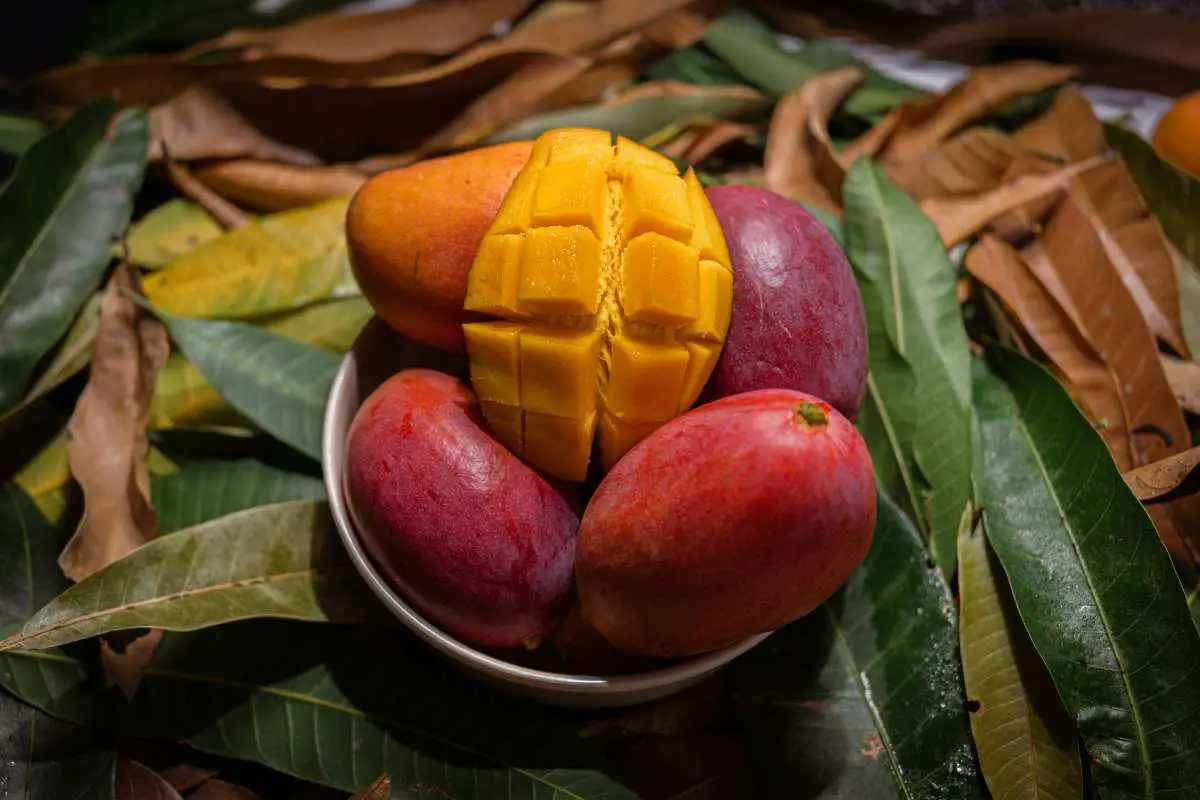Mangoes are often called the “king of fruits,” and for good reason. They bring a burst of sunshine to our plates with their vibrant colors, juicy sweetness, and tropical aroma. Whether you enjoy them fresh, in smoothies, or as part of a dessert, mangoes have a way of making every bite feel special. But there’s more to this fruit than just its taste.
Mangoes come packed with nutrients, health benefits, and versatility that make them stand out in the world of fruits.
In this blog post, we’ll dive deep into everything about mangoes. From the many types available to their nutritional value, health benefits, calories, and even recipes, we’ve got it all covered. Plus, we’ll talk about potential side effects and how to enjoy mangoes responsibly.
By the end, you’ll know why mangoes deserve a regular spot in your diet. So, let’s get started!
Table of Contents
What is Mango?

Mango is a tropical fruit that has been cherished for centuries, often referred to as the “king of fruits.” It belongs to the family Anacardiaceae and is native to South Asia, particularly Bangladesh and India, where it has been cultivated for over 4,000 years. Today, mangoes are grown in many warm climates around the world, including Mexico, Thailand, and Brazil.
The mango tree is an evergreen that can grow up to 100 feet tall, producing large, oval-shaped fruits with smooth or slightly bumpy skin. Inside, the juicy flesh ranges from golden yellow to deep orange, depending on the variety.
Mangoes are not only delicious but also packed with nutrients, making them a favorite among health-conscious eaters and food lovers alike.
This vibrant fruit comes in hundreds of varieties, each with its own unique taste, texture, and aroma. Whether eaten fresh, blended into smoothies, or incorporated into savory dishes, mangoes bring a burst of flavor and nutrition to any meal.
Also Read,
- Can You Eat Mango Skin? The Complete Truth About Mango Peels.
- Guava: Benefits, Side Effects, Nutrition, Taste, Recipes, & More.
- Can Cats Eat Mango?
Types of Mangoes: A World of Variety
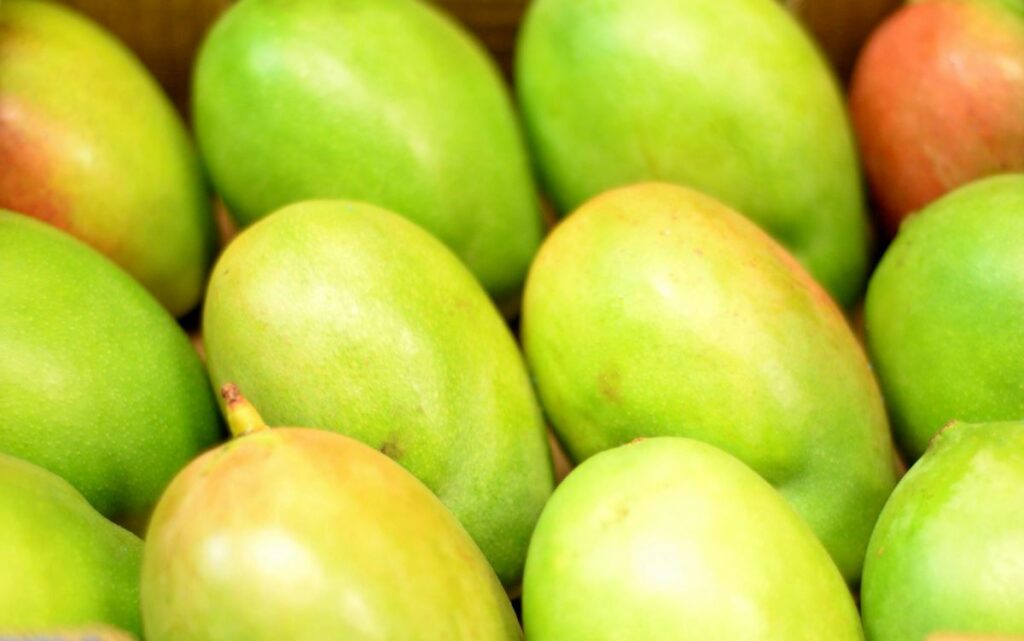
When it comes to mangoes, one size does not fit all. There are hundreds of mango varieties grown around the world, each with its own unique flavor, texture, and appearance.
Let’s explore some of the most popular ones.
Amrapali: The Hybrid Marvel
The Amrapali mango is a hybrid variety developed in 1971 by crossing two iconic Indian mango varieties: Dasheri and Neelam . Named after the legendary courtesan Amrapali from ancient Indian history, this mango is widely cultivated in Bangladesh and India, particularly in the Rajshahi, Chapainawabganj, and Natore districts in Bangladesh.
Amrapali mangoes are medium-sized with a compact shape and deep orange or red skin when ripe. They are prized for their smaller seeds , which leave more room for the smooth, creamy, and fiberless pulp. Known for their intense sweetness and rich flavor, these mangoes are perfect for fresh eating, smoothies, and desserts.
One standout feature of Amrapali mangoes is their longer shelf life , making them ideal for markets and export. Trees start bearing fruit as early as the second year of planting, and they produce high yields, even in smaller spaces.
To identify a ripe Amrapali mango, smell the stem end —a sweet, fruity aroma indicates ripeness. The skin should also have a vibrant orange or red hue, though some green may remain.
Hari Bhanga: A Regional Delicacy
The Hari Bhanga mango originates from the northwest region of Bangladesh, particularly the Rangpur district, where it is celebrated as one of the finest local varieties. Known for its vibrant yellow-green skin and fiberless, juicy pulp, this mango offers a perfect balance of sweetness and tanginess. Its refreshing taste makes it a favorite among mango connoisseurs.
Hari Bhanga mangoes are often enjoyed fresh and are also used in traditional Bangladeshi dishes like aam doi (mango yogurt) and pickles. While they may not be as widely available outside their native region, their unique flavor and texture make them a prized delicacy for those lucky enough to taste them.
Alphonso: The King of Mangoes
The Alphonso mango is often called the “king of mangoes.” It hails from India and is famous for its rich, buttery texture and sweet aroma. Its golden-yellow skin and saffron-colored flesh make it look as luxurious as it tastes. People love Alphonso mangoes for desserts like mango lassi or simply eating them fresh.
Tommy Atkins: The Global Favorite
If you’ve ever bought mangoes at a grocery store, chances are you’ve picked up a Tommy Atkins. This variety is widely available because it travels well and has a long shelf life. While its flavor may not be as intense as other types, its firm texture makes it perfect for slicing and dicing.
Kent: Sweet and Juicy
Kent mangoes are large, oval-shaped fruits with a deep orange hue. Their sweet, juicy flesh is ideal for smoothies and salads. Plus, they have fewer fibers compared to other varieties, making them a favorite among mango lovers.
Keitt: Late Bloomer with a Punch
Keitt mangoes ripen later in the season, which makes them a great option when other varieties are out of stock. They have a tangy-sweet flavor and are often enjoyed fresh. Their thick skin also helps protect the fruit during shipping.
Ataulfo: The Honey Mango
Ataulfo mangoes, also known as honey mangoes, are small and kidney-shaped. They have a rich, creamy texture and an intensely sweet flavor. These mangoes are perfect for those who prefer a sweeter taste without much acidity.
Each type of mango brings something special to the table. Whether you’re looking for sweetness, creaminess, or versatility, there’s a mango out there for everyone.
Health Benefits of Mangoes: More Than Just a Sweet Treat

Mangoes are not just delicious; they are also incredibly good for your health. Packed with vitamins, minerals, and antioxidants, these fruits offer a wide range of benefits that can improve your well-being. Let’s take a closer look.
Boosts Immunity
Mangoes are rich in vitamin C, which plays a key role in strengthening your immune system. Eating mangoes regularly can help your body fight off infections and illnesses. In fact, one cup of mango provides nearly 70% of your daily recommended intake of vitamin C. That’s a lot of protection in a single serving!
Supports Digestive Health
If you’ve ever struggled with digestion, mangoes might be your new best friend. They contain enzymes that break down proteins and fiber that keeps your digestive system running smoothly. Plus, the water content in mangoes helps prevent constipation and promotes regular bowel movements.
Promotes Healthy Skin
Who doesn’t want glowing skin? Mangoes are loaded with vitamins A and C, both of which are essential for maintaining healthy skin. Vitamin A helps repair skin tissues, while vitamin C boosts collagen production. Together, they keep your skin looking youthful and radiant.
Helps Manage Diabetes
Contrary to popular belief, mangoes can actually be beneficial for people with diabetes. They have a low glycemic index, meaning they don’t cause sudden spikes in blood sugar levels. However, moderation is key. Eating too much of anything, even mangoes, can have negative effects.
Protects Against Heart Disease
Mangoes are a great source of potassium, which helps regulate blood pressure. They also contain magnesium and fiber, both of which contribute to heart health. Including mangoes in your diet can reduce your risk of heart disease and stroke.
Fights Inflammation
Chronic inflammation is linked to many health issues, including arthritis and heart disease. Mangoes contain antioxidants like beta-carotene and quercetin, which help combat inflammation. Adding mangoes to your meals can be a simple yet effective way to keep inflammation in check.
With so many health benefits, it’s no wonder mangoes are considered a superfood. They truly are a gift from nature.
Nutritional Value of Mangoes: What’s Inside?
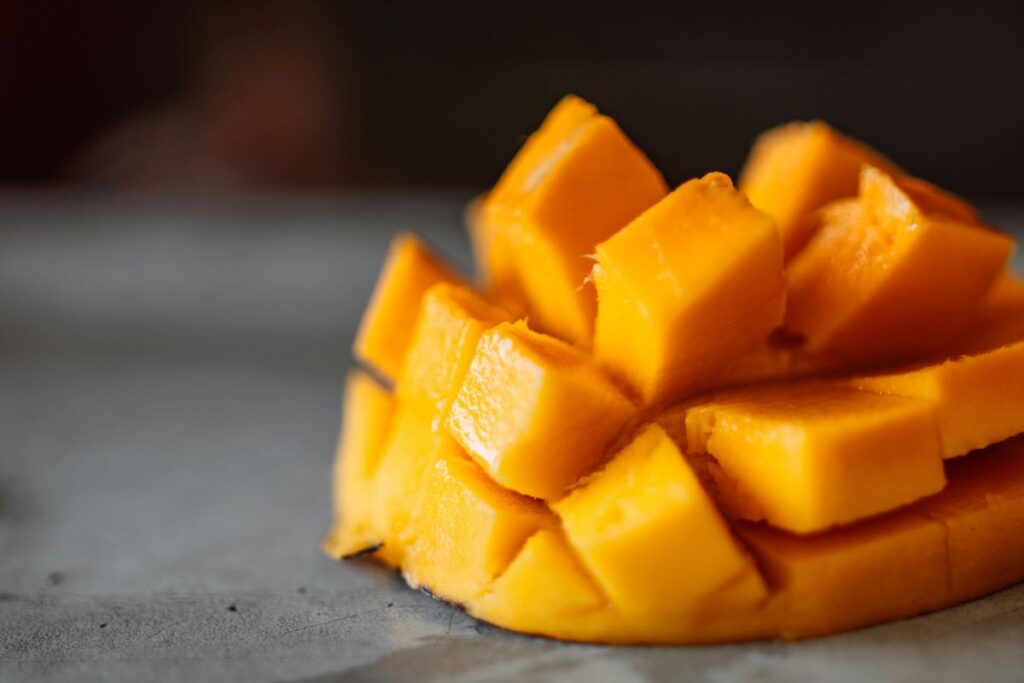
Now that we’ve talked about the health benefits, let’s break down what exactly makes mangoes so nutritious. Understanding their nutritional profile will give you even more reasons to include them in your diet.
Vitamins Galore
Mangoes are bursting with vitamins. As mentioned earlier, they are an excellent source of vitamin C, but that’s not all. They also provide vitamin A, which is crucial for eye health and immune function. Additionally, mangoes contain small amounts of B vitamins, including folate and niacin, which support energy production and brain health.
Minerals for Balance
Mangoes are rich in essential minerals like potassium, copper, and magnesium. Potassium helps maintain fluid balance and supports nerve function, while copper aids in the production of red blood cells. Magnesium, on the other hand, is important for muscle and nerve function.
Fiber for Digestion
One cup of mango contains about 3 grams of dietary fiber, which is roughly 10% of your daily requirement. Fiber is essential for keeping your digestive system healthy and preventing conditions like constipation and diverticulitis.
Low in Fat and Sodium
Mangoes are naturally low in fat and sodium, making them a heart-healthy choice. They are also cholesterol-free, which further reduces the risk of heart disease.
Hydration Powerhouse
With a water content of over 80%, mangoes are a great way to stay hydrated. This makes them an excellent snack, especially during hot summer months.
Nutritional Chart: What’s in One Cup of Sliced Mango (Approx. 165g)?
To give you a clearer picture, here’s a breakdown of the key nutrients found in one cup of sliced mango:
| Nutrient | Amount | % Daily Value |
|---|---|---|
| Calories | 99 | – |
| Total Fat | 0.6g | 1% |
| Saturated Fat | 0.2g | 1% |
| Cholesterol | 0mg | 0% |
| Sodium | 2mg | 0% |
| Total Carbohydrates | 24.7g | 9% |
| Dietary Fiber | 2.6g | 9% |
| Sugars | 22.5g | – |
| Protein | 1.4g | 3% |
| Vitamin C | 60.1mg | 67% |
| Vitamin A | 1262 IU | 25% |
| Potassium | 277mg | 6% |
| Magnesium | 12mg | 3% |
| Copper | 0.1mg | 5% |
Note: Percent Daily Values (%DV) are based on a 2,000-calorie diet.
This chart highlights just how nutrient-dense mangoes are. With high levels of vitamin C and vitamin A, along with a decent amount of fiber and potassium, mangoes pack a powerful punch in a small serving.
Why This Matters
Understanding the nutritional value of mangoes helps you make informed choices about incorporating them into your diet. For example:
- If you’re looking to boost your immune system, the vitamin C content is a big win.
- If you’re trying to improve your skin health or vision, the vitamin A is a game-changer.
- And if you need a hydrating, low-fat snack, mangoes are an excellent option.
In summary, mangoes are a nutrient-dense food that offers a wide range of vitamins, minerals, and hydration benefits. They are a smart addition to any balanced diet.
You should read, Mango Leaves: Benefits, Nutrition, Side Effects, Uses & All.
Calories in Mangoes: How Much Should You Eat?
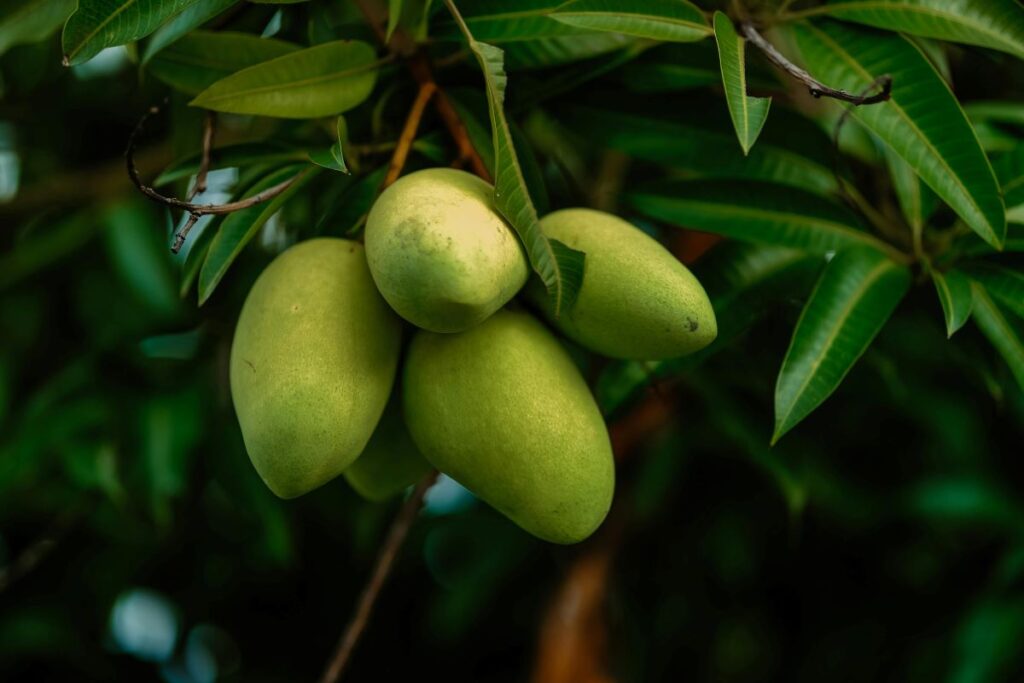
While mangoes are undeniably healthy, it’s important to be mindful of their calorie content. Like all fruits, mangoes contain natural sugars, which can add up if you eat too much. Let’s take a closer look at the calorie count and portion sizes.
Calorie Breakdown
One cup of sliced mango contains approximately 99 calories. This makes it a relatively low-calorie snack compared to processed foods. However, if you’re watching your weight, it’s important to stick to reasonable portions. For example, enjoying half a cup of mango instead of a full cup can help you manage your calorie intake.
Portion Control Tips
To avoid overeating mangoes, try pairing them with other foods. For instance, you can add a few slices of mango to your yogurt or oatmeal. This way, you still get the flavor and nutrients without consuming too many calories.
Balancing Sugar Intake
Mangoes have a moderate amount of natural sugars, which can be beneficial in small doses. However, people with diabetes or those trying to cut back on sugar should monitor their consumption. Pairing mangoes with protein-rich foods like nuts or yogurt can help slow down sugar absorption and prevent blood sugar spikes.
By being mindful of portion sizes and balancing your meals, you can enjoy mangoes without worrying about their calorie content.
The Irresistible Taste of Mangoes: Why We Love Them
Let’s face it—mangoes taste amazing. Their flavor is a perfect blend of sweetness and tanginess, making them a favorite among fruit lovers. But what exactly gives mangoes their unique taste?
Sweetness with a Twist
Mangoes are naturally sweet, thanks to their high sugar content. However, they also have a hint of acidity that balances out the sweetness. This combination creates a flavor profile that is both refreshing and satisfying.
Texture Matters
The texture of a mango can vary depending on the variety. Some mangoes, like the Alphonso, are buttery and smooth, while others, like the Tommy Atkins, are firmer and slightly fibrous. Regardless of the type, the juiciness of mangoes adds to their appeal.
Versatility in Flavor
Mangoes can be enjoyed in countless ways. Whether you eat them fresh, blend them into a smoothie, or use them in savory dishes, their flavor adapts beautifully to different preparations. This versatility is one of the reasons why mangoes are so beloved worldwide.
In short, mangoes are a treat for the taste buds. Their unique combination of sweetness, acidity, and juiciness makes them irresistible.
Delicious Mango Recipes: Get Creative in the Kitchen
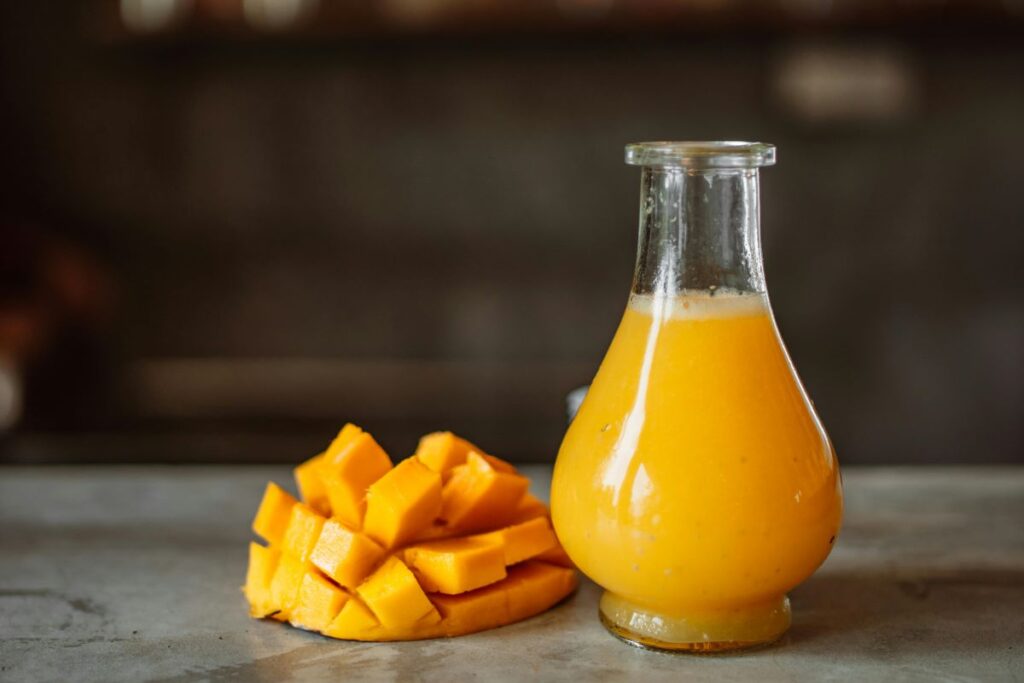
Mangoes aren’t just for snacking—they can be used in a variety of recipes to elevate your meals. Here are some ideas to inspire you.
Mango Smoothie
A mango smoothie is a quick and healthy way to start your day.
Ingredients:
- 1 ripe mango (peeled and chopped)
- 1 cup milk or yogurt
- 1 tablespoon honey
- 1/2 cup ice cubes
Instructions:
- Put all the ingredients in a blender.
- Blend until smooth.
- Pour into a glass and enjoy!
Mango Pancakes
Fluffy pancakes with mango slices taste amazing.
Ingredients:
- 1 cup flour
- 1 tablespoon sugar
- 1 teaspoon baking powder
- 1 egg
- 3/4 cup milk
- 1/2 cup mango puree
Instructions:
- Mix all the ingredients in a bowl.
- Heat a pan and pour small amounts of batter.
- Cook for 2 minutes on each side.
- Serve with extra mango slices and syrup.
Mango Salsa
Mango salsa is fresh, tangy, and perfect for chips or grilled meat.
Ingredients:
- 1 ripe mango (diced)
- 1/2 red onion (chopped)
- 1/2 red bell pepper (chopped)
- 1 tablespoon lime juice
- 1 tablespoon chopped cilantro
- Salt to taste
Instructions:
- Mix all ingredients in a bowl.
- Let it sit for 10 minutes.
- Serve with tortilla chips or grilled chicken.
Mango Salad
A mango salad is light and refreshing.
Ingredients:
- 2 ripe mangoes (sliced)
- 1 cucumber (sliced)
- 1/2 cup cherry tomatoes (halved)
- 1/4 cup chopped mint leaves
- 2 tablespoons lime juice
Instructions:
- Toss all ingredients in a bowl.
- Chill for 15 minutes before serving.
Mango Chicken
Mango and chicken make a perfect sweet and savory dish.
Ingredients:
- 2 chicken breasts (cut into cubes)
- 1 ripe mango (pureed)
- 1 tablespoon soy sauce
- 1 teaspoon garlic (minced)
- 1/2 teaspoon ginger (grated)
Instructions:
- Marinate chicken with mango puree, soy sauce, garlic, and ginger.
- Let it sit for 20 minutes.
- Cook in a pan for 10 minutes, stirring occasionally.
- Serve hot with rice.
Mango Rice
Mango rice is a simple yet tasty dish.
Ingredients:
- 2 cups cooked rice
- 1 ripe mango (diced)
- 1 tablespoon butter
- 1/2 teaspoon salt
- 1/2 teaspoon black pepper
Instructions:
- Heat butter in a pan.
- Add rice, mango, salt, and pepper.
- Stir for 5 minutes.
- Serve warm.
Mango Ice Cream
Homemade mango ice cream is creamy and delicious.
Ingredients:
- 2 ripe mangoes (pureed)
- 1 cup heavy cream
- 1/2 cup sugar
- 1 teaspoon vanilla extract
Instructions:
- Mix all ingredients in a bowl.
- Pour into a container and freeze for 4 hours.
- Scoop and serve!
Mango Cake
Mango cake is moist and full of flavor.
Ingredients:
- 1 1/2 cups flour
- 1 teaspoon baking powder
- 1/2 cup butter
- 3/4 cup sugar
- 2 eggs
- 1/2 cup mango puree
Instructions:
- Preheat oven to 350°F (175°C).
- Mix butter and sugar until fluffy.
- Add eggs and mango puree.
- Stir in flour and baking powder.
- Pour into a cake pan and bake for 30 minutes.
- Cool before serving.
Mangoes are delicious in every form. Whether you make a smoothie, salad, or dessert, they bring sweetness and freshness to your meals. Try these mango recipes and enjoy their amazing taste!
Potential Side Effects of Mangoes: Know the Risks
While mangoes are generally safe to eat, they can cause side effects in some people. Being aware of these risks can help you enjoy mangoes responsibly.
Allergic Reactions
Some people may be allergic to mangoes, particularly the skin. This is because mango skin contains urushiol, the same compound found in poison ivy. If you experience itching or swelling after eating mangoes, consult a doctor.
High Sugar Content
As mentioned earlier, mangoes are naturally high in sugar. Consuming too many mangoes can lead to weight gain or blood sugar spikes, especially for people with diabetes.
Digestive Issues
While mangoes are great for digestion, eating too many can cause diarrhea or stomach cramps. Stick to moderate portions to avoid these issues.
By being mindful of these potential side effects, you can continue to enjoy mangoes safely.
Conclusion: Why Mangoes Deserve a Spot in Your Life
Mangoes are more than just a fruit—they are a celebration of flavor, nutrition, and versatility. From their wide variety of types to their impressive health benefits, mangoes have something to offer everyone. Whether you’re blending them into a smoothie, grilling them for dinner, or simply enjoying them fresh, mangoes are sure to brighten your day.
So, the next time you see mangoes at the store, don’t hesitate to grab a few. With their sweet taste, juicy texture, and incredible health benefits, mangoes are truly a gift from nature. Enjoy them responsibly, and they’ll reward you with endless joy and nourishment.
Related FAQs:
Are mangoes good for weight loss?
Yes, mangoes can be part of a weight-loss diet if eaten in moderation. They are low in calories and high in fiber, which helps you feel full longer. However, they also contain natural sugars, so it’s best to stick to small portions.
Can diabetics eat mangoes?
Yes, diabetics can enjoy mangoes, but in moderation. Mangoes have a moderate glycemic index, so they don’t cause sudden spikes in blood sugar. Pairing them with protein or healthy fats like nuts can help balance their effects.
How do I pick a ripe mango?
To pick a ripe mango, gently press the skin—it should give slightly under pressure. Smell the stem end; a sweet, fruity aroma means it’s ready to eat. Avoid mangoes with overly soft spots or shriveled skin.
Can I eat mango skin?
While mango skin is edible and contains nutrients, it may cause allergic reactions in some people due to a compound called urushiol (also found in poison ivy). If you’re sensitive, it’s better to peel the skin before eating.
What’s the best way to cut a mango?
Cutting a mango is easy! Slice off both sides of the fruit, avoiding the large pit in the center. Score the flesh into cubes without cutting through the skin, then scoop out the pieces with a spoon. It’s quick and mess-free!
How many mangoes can I eat in a day?
One mango per day is usually enough. Eating too many mangoes can lead to excess sugar intake, which might cause bloating or diarrhea. Stick to one serving (about half a cup) to stay healthy.
Are mangoes safe for babies?
Yes, mangoes are safe for babies once they start eating solids (around 6 months old). Puree the mango for younger babies or offer small, soft chunks for older ones. Always watch for signs of allergies when introducing new foods.
Do mangoes cause acne?
Mangoes don’t directly cause acne, but their high sugar content might trigger breakouts in people prone to acne. If you notice flare-ups after eating mangoes, try reducing your intake or pairing them with low-glycemic foods.
Can mangoes help with hydration?
Absolutely! Mangoes are over 80% water, making them an excellent hydrating snack. They’re perfect for hot days or after workouts to replenish lost fluids.
How long do mangoes last in the fridge?
A whole ripe mango lasts about 5-7 days in the fridge. Once sliced, store the pieces in an airtight container—they’ll stay fresh for 2-3 days. You can also freeze mango chunks for up to 6 months.

